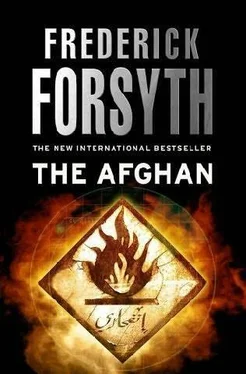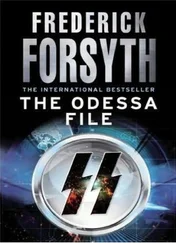Then came the computer. Software was prepared that reduced the human face to over six hundred tiny measurements and stored them. It seems every human face in the world can be broken down into measurements. It may be the exact distance to the micron between the pupils of the eyes, the width of the nose at seven points between eyebrows and tip, twenty-two measurements for the lips alone, and the ears…
Ah, the ears. Face analysts love the ears. Every crease and furrow, wrinkle and curve, fold and lobe, is different. They are like fingerprints. Even the ones on the left and right side of the head are not quite the same. Plastic surgeons ignore them, but give a skilled face-watcher both ears in good definition and he will get his “match.”
The computer software had a memory bank fare bigger than a thousand faces stored at Edzell. It had convicted criminals of apparently no political persuasion at all, because even they can work for terrorists if the price is right. It had immigrants, legal and illegal, and not necessarily Muslim converts. It had thousands and thousands of faces taken from demonstrations, as the protesters rolled by the hidden cameras, waving their placards and chanting their slogans. And it did not confine its database to the United Kingdom. In short, it had over three million human faces from all over the world. The computer broke down the face talking to the master of the Rasha, compensated for the oblique angle of the shot by picking the single image where the man raised his head to look at a jet taking off from Abu Dhabi airport, secured its six hundred measurements and began to compare. It could even adjust for added or shaved facial hair.
Fast though it was, the computer still took an hour to do its work. But it found him.
He was a face in a crowd outside a mosque just after 9/11 cheering enthusiastically whatever the orator was saying. This orator was known as Abu Qatada, fanatical Al Qaeda supporter in Britain, and the crowd he was addressing that late September day of 2001 was from al-Muhajiroun, a jihad-supporting extremist group.
Abstracting the face of the student from the file, the probationer took it to his superior. From there, it went up to the formidable lady running MI5, Eliza Manningham-Buller. She ordered that the man be traced. No one then knew the probationer had uncovered the chieftain of Al Qaeda in Britain. It took a bit more time, but another match came up; he was receiving his doctorate at an academic ceremony. His name was Ali Aziz al-Khattab, a highly Anglicized academic with a post at Aston University, Birmingham. With what the authorities had, he was either a highly successful, long-term sleeper or a foolish man who in his student days had dabbled with extreme politics. If every citizen in the second category were arrested, there would be more detainees than police.
For sure, he had apparently never been anywhere near extremists since that day outside the mosque. But a fully reformed foolish boy is not spotted conferring with the captain of the Rasha in Abu Dhabi port. So… he was in the first category: an AQ sleeper, until proven otherwise. Further discreet checks revealed he was back in Britain, resuming his laboratory work at Aston. The question was: Arrest him or watch him? The problem was, a single aerial photograph that could not be revealed would not secure a conviction. It was decided to put the academic under surveillance, costly though it was.
The quandary was solved a week later when Dr. al-Khattab booked a flight back to the Arabian Gulf. That was when the SRR was brought in. Britain has for years possessed one of the best “tracker” units in the world. It was known as the 14 thIntelligence Company, or the Detachment, or, more simply, the Det. And it was extremely covert. Unlike the SAS and the SBS, it was not designed as a unit of ultra-hard fighters. Its talents were extreme stealth and skill at planting bugs, taking long-range photos, eavesdropping and tracking. It was particularly effective against the IRA in Northern Ireland. In several cases, it was the information provided by the Det that enabled the SAS to set an ambush for a terrorist attack unit and wipe them out. Unlike the hard units, the Det used women extensively. As trackers, they were more likely to pass as harmless and not to be feared. The information they were able to bring back was indeed very much to be feared.
In 2005, the British government decided to expand and upgrade the Det. It became “the Special Reconnaissance Regiment.” It had an inaugural parade in which everyone, including the presiding general, was photographed only from the waist down. Its headquarters remain secret, and if the SAS and SBS are discreet the SRR is invisible. But Dame Eliza asked for them and got them. When Dr. al-Khattab boarded the airliner from Heathrow to Dubai, there were six from the SRR on board, scattered invisibly among three hundred passengers. One was the young accountant in the row behind the Kuwaiti. Because this was just a shadowing operation, no reason could be seen not to ask the Special Forces of the UAE for cooperation. Ever since World Trade Center terrorist Marwan al-Shehhi was discovered to have come from the UAE, and even more since the leak that the White House was tempted to bomb the Al Jazeera TV station at Qatar, the UAE had been extremely sensitive about Islamist extremism-and nowhere more than in Dubai, headquarters of the Special Forces. Thus, two hired cars and two rented scooters were available for the SRR team when it landed, just in case Dr. al-Khattab was being picked up. It was noted he had carry-on baggage only. They need not have bothered; he rented a small Japanese compact, which gave them time to move into position. He was tailed first from the airport to the Creek in Dubai, where once again the Rasha was moored after her return from Gwadar. This time, he did not approach the vessel, but stood by his car a hundred yards away until bin Selim spotted him.
Minutes later, a young man known to no one emerged from be-lowdecks on the Rasha, moved through the crowd and whispered in the ear of the Kuwaiti. It was the answer from the man in the mountains of Waziristan coming back. Al-Khattab’s face registered amazement.
He then drove along the traffic-teeming road up the coast, through Ajman and Umm al-Qaiwain and into Ras al-Khaimah. There, he went to the Hilton to check in and change. It was considerate of him, because the three young women in the SRR team could use the female washroom to change into the all-coveringjY/fcafc and get back to their vehicles.
Dr. al-Khattab emerged in his white dishdasha and drove away through the town. He adopted several maneuvers designed to shake off a “tail,” but he had no chance. In the Arabian Gulf, the motor scooter is everywhere, ridden by both sexes, and, the clothes being the same, one rider is much like another. Since being assigned to the job, the team had been studying road maps of all seven emirates until they had memorized every highway. That was how he was tailed to the villa.
If ever there had been any residual doubt that he was up to no good, his tail-shaking antics dispelled it. Innocent men do not behave like that. He never spent the night at the villa, and the SRR woman followed him back to the Hilton. The three men found a position on a hilltop that commanded a view of the target villa and kept vigil through the night. No one came or went. The second day was different. There were visitors. The watchers could not know it, but they brought the new passport and the new clothes. Their car numbers were noted, and one would be traced and arrests made later. The third was the barber, also later traced.
At the end of the second day, al-Khattab emerged for the last item. That was when Katy Sexton, tinkering with her scooter up the road, alerted her colleagues that the target was on the move.
Читать дальше










